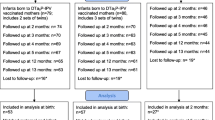Abstract
Introduction
The present study was designed as a randomized clinical trial to compare the immunogenicity, reactogenicity, and efficacy of tetanus toxoid (TT) and the combined tetanus and reduced diphtheria (Td) in pregnant women in four rural communities in Egypt. The pregnant women in each four villages received either TT or Td randomly. Both TT and Td vaccines are manufactured by the Egyptian Company for Biological Products & Vaccines (VACSERA) in Egypt. A total of 131 pregnant women were enrolled during the time of antenatal care visit (at 20 weeks gestational age of pregnancy) in one of four health units in Abu Homos district, Beheira Governorate, Egypt.
Discussion
Unimmunized women received two random doses of either TT or Td 8 weeks apart during their pregnancy. Outpatient follow-up for adverse reactions occurred at the third day after each vaccine dose as either local effects such as pain, redness, and swelling or systematic effects such as fever, malaise, and headache or body aches which was served as primary safety endpoint. Blood was collected three times from each woman for determination of antibody titer against tetanus and diphtheria by using enzyme-linked immunosorbent assay technique. The first sample was collected immediately before the first dose, the second before the second dose, and the third sample 1 week after delivery. Active surveillance home visits to all study participants were done twice: the first home visit during the first week after delivery and the second 1 month after labor to report the health status of the mother and the baby. A total of 122 pregnant women received two ordinary doses with interdose intervals within the allowable range and three blood samples were collected in each protocol analysis (62 in the TT group and 60 in the Td group). There was no statistically significant difference between groups in the percentage of reporting a primary safety endpoint (fever, malaise, body ache, headache) or local reactions at the site of injection as redness and swelling, at third day after each dose. While in the Td group, after doses I and II, there was significant reporting pain at injection site as compared with TT group, home visits clinical examination revealed that the mothers and children were normal on in both groups. However, in the TT group, some children suffered from physiological jaundice. In all women in the two groups, protective immunity for tetanus was acquired, which reflected in neutralization of antibodies at titer (>0.10 IU/ml) after complete vaccination; however, the tetanus geometric mean titers postdoses I and II were significantly higher in TT vaccines group (P < 0.001). The postvaccination seroprotection titer (>0.10 IU/ml) in diphtheria was significantly higher in Td group than the TT group; diphtheria geometric mean titers of postdose II were significantly higher in Td vaccines as compared to the other group (P < 0.0001). From this results, we can conclude that the use of Td vaccine improves immunogenicity for both tetanus and diphtheria more than the use of TT vaccine alone and we can recommend to replace TT in immunization of pregnant women.




Similar content being viewed by others
References
WHO. EPI Information systems: global summary, September 1998. WHO/EPI/GEN/98.10, Geneva, 1998.
Fauveau V, Mamdani M, Steinglass R, Koblinsky M, 1. Maternal tetanus: magnitude epidemiology and potential control measures. Int J Gynaecol Obstet. 1993;40(1):3–12. doi:10.1016/0020-7292(93)90765-O.
El-Zanaty F, Way A. Egypt demographic, health survey, 2005. Cairo: Ministry of Health and Population, National Population Council, El-Zanaty and Associates, and ORC Macro; 2006.
World Health Organization. The World Health report make every mother and child count. Geneva: World Health Organization; 2005.
Cutts F. Advances and challenges for the expanded programme on immunization. Br Med Bull. 1998;54(2):445–61.
UNICEF/WHO/UNFPA. Maternal and neonatal tetanus elimination by 2005. Strategies for achieving and maintaining elimination. Geneva: UNICEF/WHO/UNFPA; 2000.
Scientific Advisory Group of Experts (SAGE): replacing tetanus toxoid (TT) and diphtheria–tetanus toxoid (DT) with tetanus diphtheria (TD), GPV-CVI/SAGE.98/WP.04, 1998.
WHO. Vaccine and immunization safety information from GPV: global programme for vaccines and immunization: adverse events following diphtheria, tetanus and pertussis vaccines. WHO/V&B/00.36, 2000
Blackwelder WC. Proving the null hypothesis. Control Clin Trials. 1982;3:345–53. doi:10.1016/0197-2456(82)90024-1.
Newcombe RG. Interval estimation for the difference between independent proportions: comparison of eleven methods. Stat Med. 1998;17:873–90. doi:10.1002/(SICI)1097-0258(19980430)17:8<873::AID-SIM779>3.0.CO;2-I.
Mehta C, Patel N. StatXact-Turbo: statistical software for exact nonparametric inference user manual. Cambridge, MA: Cytel Software Corporation; 1992.
Demetry PH, Peter G. Active immunizing agents. In: Feigin RD, Chery JD, Demmler GJ, Kaplan SL, editors. Textbook of pediatric infectious diseases, 5th ed. Philadelphia: Saunders; 2004. p. 3136–82.
Saffar M-J, Khalilian A-R, Ajami A, Saffar H, Qaheri A. Seroimmunity to diphtheria and tetanus among mother–infant pairs; the role of maternal immunity in infant immune response to diphtheria–tetanus vaccination. Swiss Med Wkly. 2008;138(17–18):256–60.
Simonson O. Vaccination against tetanus and diphtheria, evaluation of immunity in the Danish population, guideline for revaccination, and methods for control of vaccination programs. Dan Med Bull. 1989;36:24–47.
Bayas JM, Viella A, Bertran NJ, Vidal J, Batalla J, Asenjo MA, et al. Immunogenicity and reactogenicity of adult tetanus–diphtheria vaccine. How many doses are necessary? Epidemiol Infect. 2001;127(3):451–60. doi:10.1017/S095026880100629X.
WHO. Expanded Programme on Immunization: The Immunological Basis for Immunization. WHO Documents WHO/EPI/GEN/93.13, Module 3: tetanus, 1993.
Acknowledgments
The authors gratefully acknowledge the Ministry of Health and Population, Beheira Governorate Staff in conducting the field work, the Clinical Monitors at VACSERA in monitoring the study, and the Laboratory Staff at VACSERA in conducting laboratory immune testing.
Author information
Authors and Affiliations
Corresponding author
Additional information
An erratum to this article is available at http://dx.doi.org/10.1007/s10875-011-9543-5.
Rights and permissions
About this article
Cite this article
Salama, M.M., Hady, O.A.W., Ashour, W. et al. A Randomized Controlled Trial of Oral Administration of Tetanus Toxoid (TT) Versus Tetanus and Reduced Diphtheria (Td) in Pregnant Women. J Clin Immunol 29, 524–531 (2009). https://doi.org/10.1007/s10875-009-9289-5
Received:
Accepted:
Published:
Issue Date:
DOI: https://doi.org/10.1007/s10875-009-9289-5



